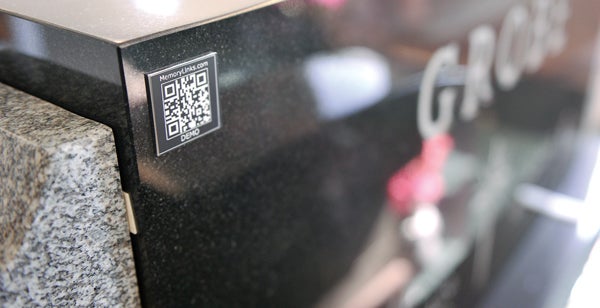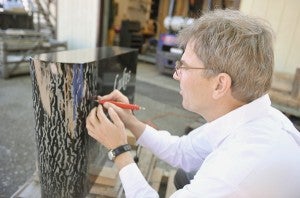Digital Memories
Published 7:00 pm Saturday, May 26, 2012

QR codes, like this one pictured, are a new and growing way people can remember loved ones. — Eric Johnson/photodesk@austindailyherald.com
QR codes are helping families remember loved ones
A small square on gravestones is telling a big story. When a group dedicated Jackie Graves’ memorial April 28 at Oakwood Cemetery, a small emblem on the top left of the stone may not have been the first thing noticed next to an engraved portrait of Austin’s legendary boxer and a pair of boxing gloves.
But Anderson Memorials owner Jeff Anderson was sure to point out the newest piece of technology on the marker: a QR code.
The code — essentially a bar code — can be photographed by a smart phone and links to www.memorylinks.com, where there’s a biography of the deceased.
Anderson said the QR codes are one of the newest ways of personalizing a gravestone and telling the story of the person’s life.
More to the story
When Anderson meets with a family to discuss a memorial, he said he tries to learn many aspects of a person.
“We’re trying to capture their life,” Anderson said. “Our product is the only thing they will ever have that will last forever that says this individual lived.”
However, the capability of telling a person’s story on a gravestone is limited by space and cost. New features like Memory Links and Smart Memorials take the possibilities of telling a story to a whole new level.
“It just expands that level of personalization that we’re already doing, but it gives an unlimited ability to find out family history,” Anderson said.
QR codes are an established technology, but Anderson said they’ve only been used on gravestones for a few years.
The codes are just starting to pick up locally as more people use smart phones.
“A couple years ago, there weren’t that many people that had smart phones,” Anderson said. “Now it’s getting to the point where it’s almost the standard.”
Through www.memorylinks.com, a QR code and the linking Web page can be set up for a one-time fee of about $249, according to Anderson. There are no monthly fees to host the page. Once the page is active, Anderson said the family can add photos, videos and text to the site as they want.
“It’s just a very easy thing for them to monitor and maintain,” he said.
The page even has a link for people visiting the site to leave a message of condolence for the family.
The page can be as elaborate as the family wants. The technology is available for the family to set up a family tree linking to the Memory Links pages of other relatives or to sites like www.ancestry.com. Families can also upload videos and photographs.
The QR codes can either be etched into black granite or secured on the stone like a plaque.
The etching is more permanent, but Anderson said it’s difficult to repair if damaged. If a QR code plaque is damaged or falls off, Anderson said they’ll just order a new one for free.
The other most common service Anderson offers is Smart Memorials, which Anderson said can be a more entry-level option similar to Memory Links. It can be as simple or extensive as the family wishes.
“They pretty much have the same capabilities,” Anderson said.
Smart Memorials also includes a link to a site, but it’s not necessarily a QR code, though that is an option. On the basic level, the family can share the login and link in cards and other items.
“This is designed to be more of something that the family would give out to people. … They don’t have to go out to the cemetery to get it,” Anderson said.
The more basic programs start as cheap as about $10, Anderson said, and can be advanced to around $250.
QR codes aren’t limited to new memorials, as Anderson said they can easily be added to new stones.
They can also be used on any type of memorial or on buildings for historical purposes or to tell where someone worked.
“It’s just unlimited what it can be used for,” Anderson said, noting they can make multiple link tabs.

While Anderson Memorial is embracing the future and what technology can do, there are still some things that need to be done by hand including this stone Jeff Anderson is working on that curves around the end and shows the same scene from both front and behind. - Eric Johnson/photodesk@austindailyherald.com
Same goal, expanding methods
For decades, Anderson said his business has thrived in personalizing memorials. In the past, most of this came out in hand-etched designs using a pen-like tool with a cutting diamond on the end.
“We’re not in the business of stamping out widgets,” Anderson said.
But, hand engraving is a labor intensive, costly technique that can take days to a week. More recently, technology has played a greater role, as Anderson Memorials has used a laser to print many of their memorials for more than a decade.
Anderson still does some engravings by hand, and is currently working on a monument that will feature the scene of a deer on one side mirrored on the opposing side with a tree trunk wrapping around a curved side to represent the family’s love of nature.
Since the laser can’t engrave the curves, Anderson is completing the process by hand.
Like laser technology, QR codes are another tool in their arsenal to tell a person’s story.
With QR codes, the memorial itself is the tip of the iceberg, with a host of information available just a few clicks away.
“Now instead of having to have everything but the kitchen sink on the monument, we’ve got everything — including the kitchen sink — linked right there,” he said of the codes.
Since the technology is new, Anderson said it’s slowly catching on. Initially, it’s been more of the young people coming in excited about QR codes. Many elderly customers are impressed by the technology, Anderson said, but aren’t familiar enough with the technology to want it.
Anderson said the young people have had the brightest response.
“You’d be surprised how many senior citizens have smart phones,” Anderson said.
Here to stay?
QR codes aren’t the first memorial technology to incorporate a biography and video. In the past, Anderson Memorials flirted with using a technology screen on memorials that included a built in screen.
Along with high costs, Anderson said people were wary of security and maintenance issues. The company managing the product went out of business before any were installed locally, according Anderson.
QR codes are much simpler, more reliable technology, he assured. The technology, Anderson predicts, is not going anywhere.
“You look 20-30 years down the road I bet you there’s going to be the majority of [memorials] doing this, because the technology is just going to be in everybody’s hand,” he said. “It’s going to be increasing in popularity as the smart phones become a mainstay.”





